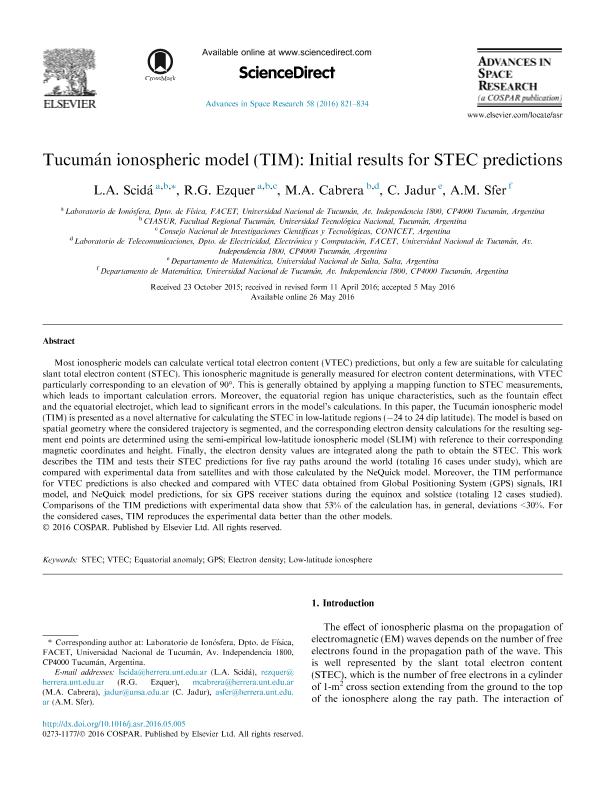Mostrar el registro sencillo del ítem
dc.contributor.author
Scida, Luis Alberto

dc.contributor.author
Ezquer, Rodolfo Gerardo

dc.contributor.author
Cabrera, Miguel Angel

dc.contributor.author
Jadur, Camilo Alberto

dc.contributor.author
Sfer, Ana María

dc.date.available
2018-09-03T16:11:21Z
dc.date.issued
2016-09
dc.identifier.citation
Scida, Luis Alberto; Ezquer, Rodolfo Gerardo; Cabrera, Miguel Angel; Jadur, Camilo Alberto; Sfer, Ana María; Tucumán ionospheric model (TIM): Initial results for STEC predictions; Elsevier; Advances in Space Research; 58; 6; 9-2016; 821-834
dc.identifier.issn
0273-1177
dc.identifier.uri
http://hdl.handle.net/11336/58063
dc.description.abstract
Most ionospheric models can calculate vertical total electron content (VTEC) predictions, but only a few are suitable for calculating slant total electron content (STEC). This ionospheric magnitude is generally measured for electron content determinations, with VTEC particularly corresponding to an elevation of 90°. This is generally obtained by applying a mapping function to STEC measurements, which leads to important calculation errors. Moreover, the equatorial region has unique characteristics, such as the fountain effect and the equatorial electrojet, which lead to significant errors in the model's calculations. In this paper, the Tucumán ionospheric model (TIM) is presented as a novel alternative for calculating the STEC in low-latitude regions (−24 to 24 dip latitude). The model is based on spatial geometry where the considered trajectory is segmented, and the corresponding electron density calculations for the resulting segment end points are determined using the semi-empirical low-latitude ionospheric model (SLIM) with reference to their corresponding magnetic coordinates and height. Finally, the electron density values are integrated along the path to obtain the STEC. This work describes the TIM and tests their STEC predictions for five ray paths around the world (totaling 16 cases under study), which are compared with experimental data from satellites and with those calculated by the NeQuick model. Moreover, the TIM performance for VTEC predictions is also checked and compared with VTEC data obtained from Global Positioning System (GPS) signals, IRI model, and NeQuick model predictions, for six GPS receiver stations during the equinox and solstice (totaling 12 cases studied). Comparisons of the TIM predictions with experimental data show that 53% of the calculation has, in general, deviations <30%. For the considered cases, TIM reproduces the experimental data better than the other models.
dc.format
application/pdf
dc.language.iso
eng
dc.publisher
Elsevier

dc.rights
info:eu-repo/semantics/openAccess
dc.rights.uri
https://creativecommons.org/licenses/by-nc-sa/2.5/ar/
dc.subject
Electron Density
dc.subject
Equatorial Anomaly
dc.subject
Gps
dc.subject
Low-Latitude Ionosphere
dc.subject
Stec
dc.subject
Vtec
dc.subject.classification
Meteorología y Ciencias Atmosféricas

dc.subject.classification
Ciencias de la Tierra y relacionadas con el Medio Ambiente

dc.subject.classification
CIENCIAS NATURALES Y EXACTAS

dc.title
Tucumán ionospheric model (TIM): Initial results for STEC predictions
dc.type
info:eu-repo/semantics/article
dc.type
info:ar-repo/semantics/artículo
dc.type
info:eu-repo/semantics/publishedVersion
dc.date.updated
2018-08-27T19:18:52Z
dc.journal.volume
58
dc.journal.number
6
dc.journal.pagination
821-834
dc.journal.pais
Países Bajos

dc.journal.ciudad
Amsterdam
dc.description.fil
Fil: Scida, Luis Alberto. Universidad Nacional de Tucumán. Facultad de Ciencias Exactas y Tecnología. Departamento de Física. Laboratorio de Ionosfera; Argentina. Universidad Tecnológica Nacional; Argentina
dc.description.fil
Fil: Ezquer, Rodolfo Gerardo. Consejo Nacional de Investigaciones Científicas y Técnicas. Centro Científico Tecnológico Conicet - Tucumán; Argentina. Universidad Nacional de Tucumán. Facultad de Ciencias Exactas y Tecnología. Departamento de Física. Laboratorio de Ionosfera; Argentina. Universidad Tecnológica Nacional; Argentina
dc.description.fil
Fil: Cabrera, Miguel Angel. Universidad Nacional de Tucumán. Facultad de Ciencias Exactas y Tecnología. Departamento de Electricidad, Electrónica y Computación. Laboratorio de Telecomunicaciones; Argentina. Universidad Tecnológica Nacional; Argentina
dc.description.fil
Fil: Jadur, Camilo Alberto. Universidad Nacional de Salta. Facultad de Ciencias Exactas. Departamento de Matemáticas; Argentina
dc.description.fil
Fil: Sfer, Ana María. Universidad Nacional de Salta. Facultad de Ciencias Exactas. Departamento de Matemáticas; Argentina
dc.journal.title
Advances in Space Research

dc.relation.alternativeid
info:eu-repo/semantics/altIdentifier/doi/https://doi.org/10.1016/j.asr.2016.05.005
dc.relation.alternativeid
info:eu-repo/semantics/altIdentifier/url/https://www.sciencedirect.com/science/article/pii/S0273117716301910
Archivos asociados
